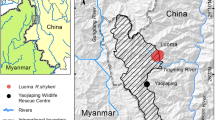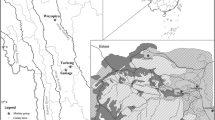Abstract
Morphological characters allow the Sichuan snub-nosed monkey (Rhinopithecus roxellana) to use multiple tree levels, but very few studies have quantified the terrestriality and tree stratum use of the species. I investigated the terrestriality and tree stratum use in a group of the monkeys from July 2003 to September 2004 (except February) in the Qianjiaping area of Shennongjia Nature Reserve, China. I collected data on the vertical position of individual monkeys in forest in relation to behavior types, diet, age/sex classes, vegetation types, tree height, and distribution of predators. The monkeys were much more arboreal than they were thought to be. They spent 97.1% of their time in trees (n = 21,234 records) and 2.9% on the ground, and mainly used the middle (74.4%) and upper strata (17.4%). The monkeys displayed all behavioral types except searching in the middle and upper strata. The percentage of use of a stratum (except the low stratum) varied among months, and there was a difference in the percentage of use of a stratum among age/sex classes and between vegetation types. Approximately 94.2% of trees used by the monkeys were >6 m tall. They mainly fed on lichens, young leaves, mature leaves, flowers, fruits or seeds, and buds in the middle and upper strata, bark in the low and middle strata and herbs on the ground. Wolf (Canis lupus), leopard (Panthera pardus), and golden eagle (Aquila chrysaetos) are predators threatening the survival of individual monkeys in the study site. The results suggested that the seasonal vertical distribution of food items eaten in forest, predators, and vegetation types had important effects on the terrestriality and tree stratum use of the monkeys.




Similar content being viewed by others
References
Altmann J (1974) Observational study of behavior: sampling methods. Behaviour 49:227–265
Bennet EL, Davies AG (1994) The ecology of Asian colobines. In: Davies AG, Oates JF (eds) Colobine monkeys: their ecology, behaviour and evolution. Cambridge University Press, Cambridge, pp 129–172
Bleisch WV, Xie J (1998) Ecology and behavior of the Guizhou snub-nosed langur (Rhinopithecus brelichi), with a discussion of socioecology in the genus. In: Jablonski NG (ed) The natural history of the Dous and snub-nosed monkeys. World Scientific, Singapore, pp 217–240
Campbell CJ, Aureli F, Chapman CA, Ramos-Ferna’ndez G, Matthews K, Russo SE, Suarez A, Vick L (2005) Terrestrial behavior of Ateles spp. Int J Primatol 26:1039–1061
Cant JGH (1992) Positional behavior and body size of arboreal primates: a theoretical framework for field studies and an illustration of its application. Am J Phys Anthropol 88:273–283
Chui JS (1996) Annals of Shennongjia (in Chinese). Hubei Science and Technology, Wuhan
Davison GWH (1982) Convergence with terrestrial Cercopithecines by the monkey Rhinopithecus roxellana. Folia Primatol 37:209–215
Dunbar DC, Badam GL (2000) Locomotion and posture during terminal branch feeding. Int J Primatol 21:649–669
Fleagle JG (1992) Primate locomotion and posture. In: Jones S, Martin RD, Pilbeam D (eds) The Cambridge encyclopaedia of human evolution. Cambridge University Press, Cambridge, pp 86–90
Fleagle JG (1998) Primate adaptation and evolution, 2nd edn. Academic, San Diego
Fleagle JG, Mittermeier RA (1980) Locomotor behavior, body size, and comparative ecology of seven Surinam monkeys. Am J Phys Anthropol 52:301–314
Gebo DL, Chapman CA (1995) Positional behavior in five sympatric old world monkeys. Am J Phys Anthropol 97:49–76
Gebo D, Chapman C, Chapman L, Lambert J (1994) Locomotor response to predator threat in red colobus. Primates 35:219–223
Happel R, Cheek T (1986) Evolutionary biology and ecology of Rhinopithecus. In: Taub DM, King FA (eds) Current perspectives in primate social dynamics. Van Nostrand Reinhold, New York, pp 305–324
Hu JC (1998) Rhinopithecus roxellana. In: Wang S (ed) China red data book of endangered animals: mammalia. Science, Beijing, pp 65–68
Hu JC, Deng QX, Yu Z, Zhou SD, Tian ZX (1980) Research on the ecology and biology of the giant panda, golden monkeys and other rare animals. J Nanchong Teach Coll 2:1–39
Kirkpatrick RC (1998) Ecology and behavior in snub-nosed and Douc langurs. In: Jablonski NG (ed) The natural history of the Dous and snub-nosed monkeys, World Scientific, Singapore, pp 155–190
Kirkpatrick RC, Long YC (1994) Altitudinal ranging and terrestriality in the Yunnan snub-nosed monkey (Rhinopithecus bieti). Folia Primatol 63:102–106
Kirkpatrick RC, Long YC, Zhong T, Xia L (1998) Social organization and range use in the Yunnan snub-nosed monkey Rhinopithecus bieti. Int J Primatol 19:13–51
Li YM (2001) The seasonal food of Sichuan snub-nosed monkey (Pygathrix roxellana) in Shennongjia Nature Reserve, China. Folia Primatol 71:40–42
Li YM (2002) The seasonal daily travel in a group of Sichuan snub-nosed monkey (Pygathrix roxellana) in Shennongjia Nature Reserve, China. Primates 43:271–276
Li YM (2004) The effect of forest clear-cutting on habitat use in Sichuan snub-nosed monkey (Rhinopithecus roxellana) in Shennongjia Nature Reserve, China. Primates 45:69–72
Li YM (2005) Effects of annual change in group size, human disturbances and weather on daily travel distance of a group in Sichuan snub-nosed monkey (Rhinopithecus roxellana) in Shennongjia Nature Reserve, China. Biodivers Sci 13:432–438
Li YM (2006) Seasonal variation of diet and food availability in a group of Sichuan snub-nosed monkeys in Shennongjia Nature Reserve, China. Am J Primatol 68:217–233
Li YM, Stanford CB, Yang Y (2002) Winter feeding tree choice in the Sichuan snub-nosed Monkey (Rhinopithecus roxellana) in Shennongjia Nature Reserve, China. Int J Primatol 23:657–675
McGrew WS, Bshary R (2002) Association of terrestrial Mangabeys (Cercocebus arys) with arboreal monkeys: experimental evidence for the effects of reduced ground predator pressure on habitat use. Int J Primatol 23:311–325
Mckey DB, Gartlan JS, Waterman PG, Choo GM (1981) Food selection by black colobus monkeys (Colobus satanas) in relationship to food chemistry. Biol J Linn Soc 16:115–146
Milton K (1979) Factors influencing leaf choice by howler monkeys: a test of some hypotheses of food selection by generalist herbivores. Am Nat 114:362–378
Napier JR (1985) Catalogue of primates in the British Museum (natural history) and elsewhere in the British Isles. III. Family Cercopithecidae, subfamily Colobinae. British Museum, London
Napier JR, Napier PH (1967) Handbook of living primates. Academic, London
Nowak RM (1999) Walker’s primates of the world. The Johns Hopkins University Press, Baltimore
Oates JF, Davies AG (1994) What are the colobines? In: Davies AG, Oates JF (eds) Colobine monkeys: their ecology, behaviour and evolution. Cambridge University Press, Cambridge, pp 1–10
Oates JF, Waterman PG, Choo GM (1980) Food selection by the south Indian leaf-monkey, Presbytis johnii, in relation to leaf chemistry. Oecologia 45:45–56
Ren BP, Zhang SY, Wang LX, Liang B, Li BG (2001) Vertical distribution of different age–sex classes in a foraging group of Sichuan golden monkeys (Rhinopithecus roxellana). Folia Primatol 72:96–99
Su YJ, Ren RM, Yan KH, Li JJ, Zhou Y, Zhu ZQ, Hu ZL, Hu YF (1998) Preliminary survey of the plot and ranging behavior of golden monkeys (Rhinopithecus roxellana) in Shennongjia National Natural Reserve, Hubei, China. In: Jablonski NG (ed) The natural history of the Dous and snub-nosed monkeys. World Scientific, Singapore, pp 255–268
Tan B, Poirier S (1988) Status report on some Chinese primates. Primate Conserv 9:129–131
Wang YX, Jiang XL, Liu DW (1998) Classification and distribution of the extant subspecies of golden snub-nosed monkey (Rhinopithecus roxellana). In: Jablonski NG (ed) The natural history of the Dous and snub-nosed monkeys. World Scientific, Singapore, pp 53–64
Waterman PG, Choo GM (1981) The effect of digestibility-reducing compounds in leaves on food selection by some colobinae. Malays Appl Biol 10:147–162
Waterman PG, Kool KM (1994) Colobine food selection and plant chemistry. In: Davies AG, Oates JF (eds) Colobine monkeys: their ecology, behaviour and evolution. Cambridge University Press, Cambridge, pp 251–284
Wu BQ (1993) Patterns of spatial dispersion, locomotion, and foraging behavior in three groups of Yunnan snub-nosed landue (Rhinopithecus roxellana) on Baimaxue Mountains, northwestern Yunnan Province, China. Folia Primatol 60:63–71
Wu BQ, Tai Z, Ji W (1988) A preliminary survey of ecology and behavior on Yunnan snub-nosed monkey (Rhinopithecus bieti) group. Zool Res 9:373–384
Youlatos D (2002) Positional behavior of black spider monkeys (Ateles paniscus) in French Guiana. Int J Primatol 23:1071–1093
Zhang SY, Ren BP, Li BG (1999) A juvenile Sichuan gold monkey (Rhinopithecus roxellane) predated by a Goshawk (Accipiter gentilwas) in the Qinling Mountains. Folia Primatol 70:175–178
Zhu ZQ (1992) Status and conservation of snub-nosed monkey at Shennongjia Nature Reserve (in Chinese). Chin Wildl 67:16–17
Acknowledgements
I thank the Bureau of Shennongjia Nature Reserve for permitting the study and JL Yang, YG Sun, and YF Li for their assistance in the field work. I am grateful to Lois Lippold, Hideshi Ogawa, and an anonymous reviewer for comments and Craig Stanford for improving the language of the manuscript. Financial support was provided by the National Science Foundation (code: 30670354) and the Chinese Academy of Sciences (KSCX2-SW-118 and KSCX3-IOZ-02).
Author information
Authors and Affiliations
Corresponding author
About this article
Cite this article
Li, Y. Terrestriality and tree stratum use in a group of Sichuan snub-nosed monkeys. Primates 48, 197–207 (2007). https://doi.org/10.1007/s10329-006-0035-9
Received:
Accepted:
Published:
Issue Date:
DOI: https://doi.org/10.1007/s10329-006-0035-9




